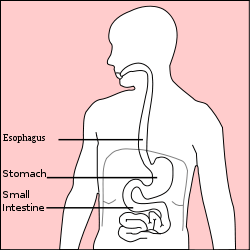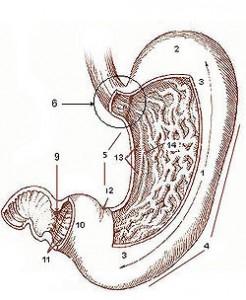Introduction:
Separating the nutrients our bodies need from the food that we eat is almost certainly the biggest challenge our bodies face daily. Digesting our meals requires much of our energetic capacity, and many other bodily functions slow or stall until our food is broken up. We experience this as coldness in our extremities or our brains getting sleepy as our blood moves into our core to support stomach functions (more details). Once our meals have been deconstructed into a useable form they are pushed into our small intestines where microbes take over the heavy lifting, freeing our energy up. This is why we only need to focus our energetic resources on digestion for a couple of hours. The Stomach is a highly acidic holding chamber that works on the food we eat as a batch. It is helpful to consider the processes from the perspective of the acid, which our bodies make by converting water and salt into hydrochloric acid.
Hydrochloric Acid and Acid Reflux / Indigestion (HCL)
Acid reflux is usually presented as excess stomach acid. Our usual response is to take antacids which makes the symptoms dissipate. Much of the time this is not a case of too much stomach acid, but rather too little. In a healthy stomach concentrated acid is not a problem, but if the acid gets up into the esophagus, it will irritate the tissue. The esophageal sphincter (Fig 2 #6) is what prevents this from happening. When closed, it prevents acid from migrating up into the esophagus and causing problems. The signal that the esophageal sphincter uses to stay closed is the acid level in the stomach. When there is enough acid, the sphincter stays tightly closed, but when the acid level gets low enough, it will relax, allowing acid up into the esophagus.
This correlates nicely with the experience of eating a heavy meal and then experiencing acid reflux. Breaking down the food would consume the majority of the acid resources of the stomach, and in older people, a big meal might need more acid than they can make. The diluted acid level allows the esophagus to open and the acid to migrate upward, irritating possibly already inflamed tissue. The unfortunate choice of reaching for the antacid shuts down whatever acid function they had, removing the irritation, but also ceasing digestion of the meal, which then moves into the Small Intestines in a non-assimilateable form. The solution to this is to take extra hydrochloric acid with the meal. It can be found at any health food store, often as Hydrochloric (HCL) Betane. This adds stomach acid, helping to fully break down the food and keeping the esophageal sphincter closed. The truth of this is in the experience. If the antacid commercials are correct, adding acid should make the symptoms worse, and yet using HCL Betane makes them dissipate1.
Hydrochloric Acid Levels and Gall Bladder Function
Another function that relies on acidity is bile excretion. Bile is collected from our blood by the liver and contains many components that neutralize acidity, further prepare the food for nutrient assimilation, and eliminate toxins, particularly heavy metals. When food leaves the stomach by the pyloric sphincter (Fig 2 #9) if it is not acidic enough bile will not be excreted. In addition to limiting nutrient absorption, the backup of metals and toxins can have a strong negative effect on overall health.
If you are changing how you eat, it is important to consider adding Chlorella to your meals. In addition to being extremely nutritionally beneficial, Chlorella binds to heavy metals and prevents them from being reabsorbed through the lining of the small intestines.
Hydrochloric Acid (HCL) and losing weight
The better the job the stomach has done in breaking loose the nutritional content of our food, the easier it is for the small intestines to absorb those nutrients. When the stomach acid is low or the food has been eaten too quickly, food can pass through the intestines without any nutrients being absorbed, essentially throwing away the energy invested in digestion. When food is routinely partially digested we can remain hungry after eating as our bodies are craving nutrients (which were in the food we ate) that we were unable to absorb. This can create a cycle where we are always hungry, eat a lot, and put on weight, but are malnourished. This type of metabolic imbalance is easily seen in a Trace Element Tissue Analysis.
Digestion and Stress
Digestion is managed by some of our most ancient neurology, our Autonomic Nervous Systems (ANS). The ANS balances the function of two sub-systems. The Sympathetic Nervous System (SNS) focuses outward, getting resources and evaluating whether to fight or to run away. The Para-Sympathetic Nervous System (PNS) focuses inward, managing our energy so that we can digest our meals. The two sub-systems are antagonistic to each other so that if one is active, the other is suppressed as if they are on a seesaw. Stress stimulates the function of the SNS, thereby suppressing PNS activity. The more suppressed PNS activity, the less successful digestion will be, resulting in the scenarios discussed above. Essentially, stress results in compromised digestion and chronic stress manifests as chronic poor digestion. This can turn into a viscous cycle where compromised digestion increases stress which compromises digestion further. The way out is to “shelve” stressors while you eat. [Article in the Wall Street Journal on this issue]
What We Can Do:
Eat Smaller Meals: Smaller, more frequent meals allow the system to work better. This may be the most significant difference between our(US) culture of food and European and other cultures where food is consumed slowly. The epidemic of obesity which the Europeans have largely bypassed may be a consequence of the culture of food, where more frequent meals of small proportions are consumed. Because our stomachs have a set capacity to store HCL, with smaller meals, the ratio of HCL to food is increased.
Eat Our Meals Slowly: Allowing the saliva in our mouths to replenish and stomach acid to work on one bite of food before it receives the next one is beneficial. If we eat slowly, our bodies have time to tell us when it is full. [Great article in the NY Times on Mindful Eating]
Chew the Food A Lot: Breaking food into small pieces and working them over with saliva is a much better preparation.
Eat with friends: There is current research (more info) indicating that being alone ratchets up our protective responses, increasing stress and inhibiting our digestive functions.
Pay Attention to our Gut Flora: BLOG POST ON THE GUT MICROBIOME
Add HCL Betane and Chlorella to our meals: To be most effective, the HCL Betane should be taken at or near the beginning of the meal, like an appetizer, and the Clorella near the end of the meal, like a dessert. Or if you think of a meal as a train, the HCL (and Pro-Biotics and/or digestive enzymes – see assimilation post) is the engine, the meal is the cars and the Chlorella is the caboose.
After we digest, we assimilate. This post discusses some of the attributes of assimilation.
1: Protocol to Assess Adequate HCL Levels:
Day 1 – eat a cup of beets
Day 2 – look at pee- is it pink or red? If yes, then NO HCL. If it isn’t red… Then yes HCL.
Now… Take one HCL before each meal.
***If no heartburn, increase to 2 pills before each meal… Continue increasing each day, if no heartburn.
Once you have heartburn subtract one pill from your before-meal regimen. And continue with that number…
Then later you might get heartburn… Start decreasing the pills until no heartburn… Eventually, you are off the HCL and your body makes it.


